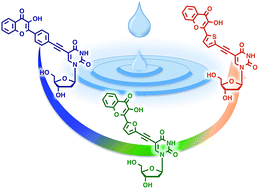Development of environmentally sensitive fluorescent and dual emissive deoxyuridine analogues†
Abstract
Ratiometric and environment-sensitive fluorescent dyes present attractive advantages for sensing interactions in DNA research. Here, we report the rational design, synthesis, and photophysical characterization of 2-thienyl-, 2-furyl- and 2-phenyl-3-hydroxychromones bonded to the C-5 position of deoxyuridine. Since these two-color nucleosides were designed for incorporation into ODNs, we also investigated the sensitivity of the ratiometric response to hydration by using acetonitrile/water mixtures and neat solvents. The synthesized 2-thienyl and 2-furyl conjugates were found to exhibit more red-shifted absorption (by 31–36 nm) and emission (by 77–81 nm of the N* band), two-fold increased molar absorption coefficients, and dramatically enhanced (by 3–4.5 times) fluorescence quantum yields. Demonstrating a manifold increase in brightness, they preserve the ability of exquisite ratiometric responses to solvent polarity and hydration. This makes the new fluorescent nucleoside analogues highly relevant for subsequent labeling of the major groove in nucleic acids and sensing their interactions.


 Please wait while we load your content...
Please wait while we load your content...